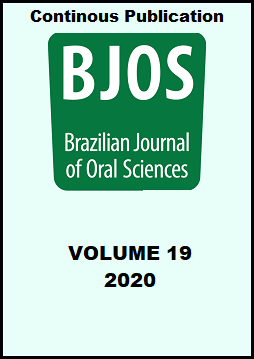Abstract
Aim: To evaluate the prevalence of sleep bruxism in childrenbetween 2 to 6 years old in primary dentition in a public school(A1) and a private school (A2) in the state of Piauí. Method: Itwas cross-sectional and quantitative study in 370 participants,180 in A1 and 190 in A2. The questionnaire to help diagnosebruxism was applied to parents. In the clinical examination,dental wear was evaluated, checking for the presence ofshiny and polished facets on deciduous incisors and / ormolars (palatal surface, incisal edges and working cusps)and the results were noted in the odontogram. Students whohad bruxism participated in group 1 (G1) and those who didnot have it were in the control group (CG) in both A1 and A2.Results: One hundred and five children had sleep bruxism.Tooth wear was more prevalent in the male gender. Both in A1and in A2 and in both genders, wear on primary molars wasmore frequent than in canines. Conclusion: The prevalence ofbruxism in children between 2 and 6 years of age was 28.3%,with a predominance in males. There was an associationbetween sleep bruxism and the habit of sucking a finger,pacifier, bottle use and the habit of awake bruxism. In 98.09%of the children who had sleep bruxism, teeth pain was found.
References
Vieira-Andrade RG, Drumond CL, Martins-Junior PA, Correa-Faria P, Gonzaga GC, Marques LS, et al. Prevalence of sleep bruxism and associated factors in preschool children. Pediatr Dent. 2014; 36(1):46-50.
Lobbezoo F, Ahlberg J, Raphael KG, Wetselaar P, Glaros AG, Kato T, et al. International consensus on the assessment of bruxism: Report of a work in progress. J Oral Rehabil. 2018 Nov;45(11):837-844. doi: 10.1111/joor.12663.
Gomes MC, Neves ÉT, Perazzo MF, Souza EGC, Serra-Negra JM, Paiva SM, et al. Evaluation of the association of bruxism, psychosocial and sociodemographic factors in preschoolers. Braz Oral Res 2018 Feb;32(1):9-16. doi: 10.1590/1807-3107bor-2018.vol32.0009.
Castelo PM, Gavião MB, Pereira JL, Bonjardim LR. Relationship between oral parafunctional/nutritive sucking habits and temporomandibular joint dysfuction in primary dentition. Int J Paediatr Dent. 2005;15(1):29-36. doi: 10.1111/j.1365-263X.2005.00608.x.
American Academy of Sleep Medicine. International classification of sleep disorders. Diagnostic and Coding Manual. Westchester, IL: AASM; 2005. Vol. 2. 208p.
Lam MH, Zhang J, Li AM, Wing YK. A community study of sleep bruxism in Hong Kong children: association with comorbid sleep disorders and neurobehavioral consequences. Sleep Med. 2011 Aug. 12(7):641-5. doi: 10.1016/j.sleep.2010.11.013.
Serra-Negra J M, Ramos-Jorge ML, Flores-Mendoza CE, Paiva SM, Pordeus IA. Influence of psychosocial factors on the development of sleep bruxism among children. Int J Paediatr Dent. 2009 Sep;19(5):309-17. doi: 10.1111/j.1365-263X.2009.00973.x.
Clementino MA, Siqueira MB, Serra- Negra JM, Paiva SM, Granville-Garcia AF. The prevalence of sleep bruxism and associated factors in children: a report by parents. Eur Arch Paediatr Dent. 2017 Dec;18(6):399-404. doi:10.1007/s40368-017-0312-x.
Drumond CL, Ramos-Jorge J, Vieira-Andrade RG, Paiva SM, Serra-Negra JMC, Ramos-Jorge ML. Prevalence of probable sleep bruxism and associated factors in Brazilian schoolchildren. Int J Paediatr Dent. 2018.29(2):221-7. doi:10.1111/ipd.12443.
Feitosa GMA, Félix R C R, Sampaio DC, Vieira-Andrade RG, Santos CCO, Fonseca-Silva T. Bruxism during childhood behavior profile, features of sleep and symptomatology. Rev Bahiana Odonto. 2016;7(2):94-104. doi: 10.17267/2238-2720.
Sousa HCS, Lima MDM, Dantas Neta NB, Tobias RQ, Moura MS, Moura LFAD. [Prevalence and associated factors to sleep bruxism in adolescents from Teresina, Piauí]. Rev Bras Epidemiol. 2018;21:e180002. doi: 10.1590/1980-549720180002. Portuguese.
Rodrigues JA, Azevedo CB, Chami VO, Solano MP, Lenzi TL. Sleep bruxism and oral health‐related quality of life in children: a systematic review. Int J Paediatr Dent. 2019 Sep;30(2):1-8. doi:10.1111/ipd.12586.
Luchesa CJ, Chaves Neto A. [Calculation of sample size in administration surveys]. Curitiba: Edição do autor; 2011. 27p. Portuguese.
Owens JA, Spirito A, McGuinn M. The children´s sleep habits questionnaire (CSHQ): psychometric properties of a survey instrument for school-aged children. Sleep. 2000;23(8):1043-51. doi: 10.1037/t33022-000.
Junqueira TH, Nahás-Scocate ANR, Valle-Corott JM, Conti ACCF, Trevisan S. Association of infantile bruxism and the terminal relationships of the primary second molars. Braz Oral Res. 2013 Jan;27(1):42-7. doi:10.1590/S1806-83242013000100008.
Alves CL, Fagundes DM, Soares PBF, Ferreira MC. Knowledge of parents/caregivers about bruxism in children treated at the pediatric dentistry clinic. Sleep Sci. 2019;12(3):185-9. doi: 10.5935/1984-0063.20190083.
Insana S, Gozal D, McNeil DW, Montgomery-Downs HE. Community based study of sleep bruxism during early childhood. Sleep Med. 2012;14(2):183-8. doi:10.1016/j.sleep.2012.09.027.
Renner AC, Silva AA, Rodriguez JD, Simões VM, Barbieri MA, Bettiol H. Are mental health problems and depression associated with bruxism in children? Community Dent Oral Epidemiol. 2012 Nov;40(3):277-87. doi: 10.1111/j.1600-0528.2011.00644.x.
Simões-Zenari M, Bitar M L. [Factors associated to bruxism in children from 4-6 years]. Pro Fono. 2010;22(4):465-72. doi:10.1590/s0104-56872010000400018. Portuguese.
Miamoto CB, Pereira LJ, Ramos-Jorge ML, Marques LS. Prevalence and predictive factors of sleep bruxism in children with and without cognitive impairment. Braz Oral Res. 2011 Sep-Oct;25(5):439-45. doi:10.1590/s1806-83242011000500011.
Lamelha RML, Cavalcanti MCC, Mello LF, Vilela MH, Santos-Junior VE. Probable sleep bruxism in children and its relationship with harmful oral habits, type of crossbite and oral breathing. J Clin Pediatr Dent. 2020;44(1):66-9. doi:10.17796/1053-4625-44.1.12.
Orengul AC, Tarakcioglu MC, Gormez V, Akkoyun S, Zorlu A, Aliyeva N, et al. Duration of breastfeeding, bottle-feeding, and parafunctional oral habits in relation to anxiety disorders among children. Breastfeed Med. 2018 Nov;14(1):57-62. doi:10.1089/bfm.2018.0013.
Goldstein RE, Auclair WC. The clinical management of awake bruxism. J Am Dent Assoc. 2017 May;148(6):387-91. doi:10.1016/j.adaj.2017.03.005.

This work is licensed under a Creative Commons Attribution 4.0 International License.
Copyright (c) 2020 Brazilian Journal of Oral Sciences


